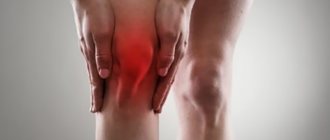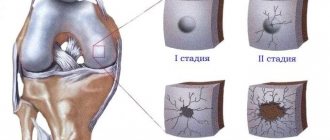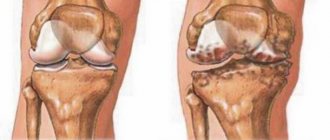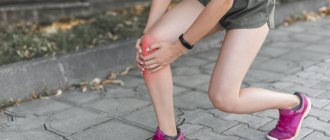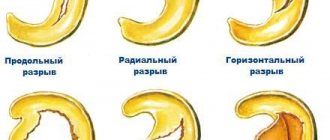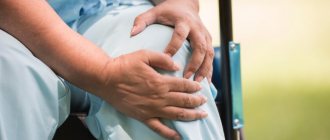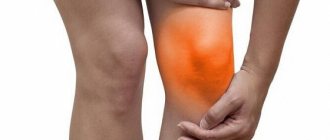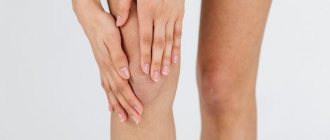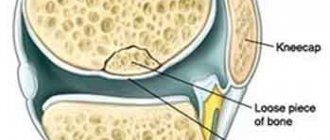A person’s daily life is unthinkable without physical activity, and therefore diseases that lead to a decrease in it are perceived as especially painful at any age. Osteoarthritis of the knee joint, also called gonarthrosis, occupies a special place among such diseases. The knee joint is located lower than most others, and therefore experiences the greatest load. It can occur not only when walking, but also when sitting in an uncomfortable position.
Over 75% of elderly people complain of symptoms associated with gonarthrosis. In advanced cases, even moving around the apartment becomes difficult—to get to the kitchen, the patient needs crutches or the help of loved ones. Osteoarthritis of the knee joints is one of the 10 main causes of disability in Russia. However, the disease can be prevented at a young age - in the early stages its development can be significantly slowed down, the main thing is to learn in time how to treat osteoarthritis of the knee joint.
Knee pain - causes
With age, the vast majority of people face the acute question of how to treat arthrosis of the knee joint, with the typical symptoms inherent in this disease at its different stages. This includes the appearance of swelling in the knee area, redness around these swellings, creaking and rustling, clearly audible in silence when the knee moves, especially during squats, and a distinct pain syndrome of varying degrees of intensity. Pain can appear immediately after normal, everyday physical activity or after physical exercise that is inappropriate for age in duration and intensity. When touching on the underlying causes of this pain, we must keep in mind that its appearance can also be the result of:
- Inflammatory process in the knee joint. That is, be a consequence of arthritis. It occurs as an independent pathology or as a complication from other diseases.
- Arthrosis is a degenerative process during which the tissues of the joint are destroyed, it loses mobility, and if the course of arthrosis has been prolonged, it also causes deformation of the joint.
- Injuries. Most often it occurs from a fall, a blow to the knee, or a blow to the knee on a hard surface. The joint may become deformed.
- Ligament damage. Ligaments hold the joint in the correct position, preventing it from moving. But when they are damaged (stretched, displaced, ruptured), the joint also suffers - with severe pain and the appearance of a tumor. In order not to aggravate the injury, in such cases, urgent medical attention and rest for the injured leg are needed.
- Damage to the meniscus of the kneecap. This protruding, round, movable cartilage in the knee can be injured even when squatting or turning sharply. It is not always detected visually due to swelling of the knee joint that often occurs in such cases. Accurate diagnosis is made using ultrasound, x-rays, and palpation by an experienced specialist.
- Popliteal cyst (Becker's cyst). As a result of inflammation, fluid is formed in the joint, which accumulates in the inner side of the popliteal fossa, in the area of the tendons.
- Inflammation of ligaments and tendons (tendinitis). They cause unpleasant, painful sensations localized along the ligaments and are accompanied by swelling. The pain intensifies when the knee is used (flexion and extension), radiates to the area along the muscles along the ligaments and nerves, above the knee, into the femoral ligaments and muscles, and below - into the lower leg.
- Ischemic pain, from impaired blood circulation in the knee joints. They can appear from a sudden change in weather, severe hypothermia for a long time. Examples are sailors who work for a long time in high (arctic) latitudes. In most cases, the localization of pain is symmetrical, equally intense, and at the first stage does not affect joint mobility.
The most serious mistake in such cases would be to ignore the pain and hope that if you just rest, “everything will go away on its own.” Only a specialist can give recommendations for treatment and make a correct diagnosis, therefore treatment of arthrosis of the knee joint is unacceptable at home only on the basis of advice from “knowledgeable people”, and even purely using traditional medicine. Effective treatment is possible only with a combination of medications in the form of tablets, rubbing, ointments, and the use of physiotherapy. Sometimes, in severe or advanced cases, surgery cannot be avoided.
Causes of arthrosis
- Destruction of the joint due to natural wear and tear (aging of the body).
- Hormonal disorders (menopause, endocrine diseases).
- Congenital defects of the musculoskeletal system.
- Injuries, surgery on the knee joint.
- Professional sports.
- Monotonous physical work with increased load on the knee joints.
- Excess body weight.
- Genetic predisposition.
- Autoimmune diseases.
Establishing diagnosis
An orthopedic surgeon can make a diagnosis of arthrosis of the knee joint after movement tests and medical history. The following procedures are usually prescribed as additions to diagnostics:
- Relating to laboratory tests, such as a biochemical blood test and bacterial microflora, smear, puncture of joint fluid and/or bone marrow, serological analysis, that is, a study for the presence of antibodies and antigens contained in the blood serum.
- Instrumental studies, which may include ultrasound, magnetic resonance imaging, densitometry and others.
- Examination of the internal joint capsule using an arthroscope - a device for a minimally invasive procedure for penetrating the cavity through an incision. Most often, this method is used after damage to the meniscus or with cracks and severe wear of the cartilage tissue, as well as to restore the anterior cruciate ligaments. Although recently the anthroscope has rarely been used as a diagnostic tool, it has been successfully replaced by a completely non-invasive diagnostic method using MRI.
- Just “by ear” - with a 3rd degree articular lesion, extraneous sounds in the form of creaks, rustles, and clicks are clearly audible in the joint.
The information obtained is brought together into a general history, and only on the basis of it can full and effective treatment begin.
What you need to know about endoprosthetics
Today, surgery is the most effective method of treating grade 3 osteoarthritis of the knee joint. With its help, you can completely get rid of chronic pain and restore normal knee mobility. A properly installed modern implant can last at least 15-20 years.
The success of endoprosthetics depends on the skill of the surgeon and the quality of the endoprosthesis. The implant must suit the patient according to a number of criteria. Negligent attitude of doctors towards the selection and installation of a prosthesis can lead to unpleasant consequences. Poor quality rehabilitation or its complete absence can also cause harm.
How to treat gonarthrosis?
Restoring joint mobility is not a matter of one month. The treatment is complex, it is expensive due to the high cost of drugs, and the result depends only on the patient’s desire to cooperate with the doctor and strict adherence to all medical recommendations and prescriptions.
But first. What needs to be done is to immediately reduce the load on the affected joint(s). If the work involves such stress, negotiate with management (if necessary, with doctor’s notes in hand) about changing your type of activity. For a while or forever - life will tell. Although often at first, bed rest may be required for the initial restoration of joint function. Remember: a joint is not a muscle, you cannot “work it out” with intense exercise, it will only make it worse. Activation of life with intense movements may be required later, after the most acute inflammation has subsided. But even when increasing the load, you need to use means of support in the form of elastic elastic bandages, a cane, a crutch, etc. Sometimes you cannot do without special orthopedic insoles or even custom-made orthopedic shoes.
Treatment of arthrosis of the knee joint is also possible at home, using outpatient medications prescribed by a doctor - chodroprotectors, painkillers and anti-inflammatory drugs. Depending on the degree of damage to the joint and the type of inflammation, the doctor may prescribe nonsteroidal anti-inflammatory drugs (NSAIDs). But for all their effectiveness in relieving symptoms, they do not eliminate the causes of the disease.
Do not heat sore joints with arthrosis! On the contrary, apply an ice pack to the inflamed area - it will help relieve swelling, redness and inflammation.
The use of chondroprotectors, on the contrary, does not relieve pain. But the restoration of cartilage tissue will proceed slowly but surely. The only question is the effectiveness of the drug, but you should try to use proven and certified medications for treatment. Preferably internationally recognized.
For some types and degrees of joint damage, applying and permanently (or temporarily) wearing a tightening bandage that fixes the joint can help. But this measure should be used only if the method is approved by the attending physician, since in some types of arthrosis, wearing such a bandage can aggravate the course of the disease.
You cannot completely immobilize yourself if you have knee pain. Moreover, with some types of inflammation, moderate physical activity only benefits the joint. An orthopedic doctor will tell you when and how much to exercise. Moreover, complete passivity in terms of physical activity will cause weight gain, and this will further aggravate the situation, loading the joint.
Drug treatment is usually combined with courses of physiotherapy, the most favorable for the treatment of arthrosis: magnetic and laser therapy (coherent laser radiation is used at safe frequencies), mechanical vibration and ultraphonotherapy, microwave installations with deep effects on tissue - when this is therapeutically justified.
In diagnosis, three degrees of arthrosis of the knee joint are distinguished.
Arthrosis I degree
The mildest degree of the disease. It is characterized by the fact that treatment does not require a large degree of medicinal influence, the list of medications is small, and measures involving physiotherapy, massage, and exercise therapy help well. One of the most effective methods is considered to be laser therapy, which significantly reduces pain, stimulates the regeneration of irradiated areas, and reduces inflammation. In addition, the use of coherent radiation with a strictly defined wavelength eliminates the need to use glucocorticosteroids in treatment, which cause a lot of side effects.
Arthrosis II degree
It is characterized by more intense and acute processes of inflammation and degeneration of cartilage tissue. In the acute period, special medications are prescribed, a special diet is recommended, and physical therapy designed for such cases is recommended. Physiotherapy and massage are excluded during these periods.
Recommendations: reducing the load on the affected joint, limiting walking, avoiding any movements associated with squatting. Special orthoses may be prescribed for the knee joint - devices that fix the joint and severely limit its mobility.
In the medical arsenal for the treatment of arthrosis of the second degree, along with chondroprotectors with glucosamine and chondroitin, steroid drugs, as well as anti-inflammatory non-steroids, may be present. It is possible to inject hyaluronic acid and other drugs into the joint capsule to facilitate the sliding of cartilage surfaces relative to each other.
A special diet with excess collagen is prescribed: jellied meat, jelly, aspic, and from confectionery products - gelatin soufflé. Including fish oil in your diet is beneficial.
Arthrosis III degree
When the knee joint is affected by arthrosis of the third degree, the treatment is not much different from the previous condition - except that the frequency of use of medications increases with a slight shift towards glucocorticosteroid hormones. If there are no results, there is a need for surgery followed by joint replacement.
Chondroprotectors
Their action is mainly aimed at preventing further destruction of articular cartilage (chondroitin) and normalizing the properties of joint fluid (glucosamine). Most often used
Artra
Structum
Alflutop
Chondrolone
Gonarthrosis of the knee joint
All of the above applies mainly to people of working age, when organic damage to the knee joint is caused by extreme circumstances and is in no way related to the aging of the body.
A completely different picture emerges when a person passes the age of 50 - when the flexibility of ligaments is lost, processes of tissue dehydration begin, and metabolism slows down.
Under these conditions, the development of gonarthrosis begins - deforming arthrosis of varying severity. In the classification accepted in medicine, gonarthrosis of the knee joint is divided into degrees I, II and III.
This disease, once it begins, progresses very quickly. Refers to acquired age-related pathologies of the musculoskeletal system. To one degree or another, it is inherent in all patients after 50 - another thing is that by leading a healthy lifestyle and avoiding extreme physical activity, the integrity of the cartilage layer in the joints can be preserved both after 70 and after 80 years.
Possible onset of the disease
Located between the tibia and femur bones, the knee joint in the human body bears perhaps one of the heaviest loads. An example would be regular running on a hard (most often asphalt) surface: each step in such running causes a shock load on the knee joint.
This joint also includes the largest sesamoid movable bone - the patella, located at the crown of the tendons of the quadriceps femoris muscle. The articular surfaces are covered with a thick, up to 2.5 mm, cartilaginous membrane consisting of chondrocytes. Medicines under the general name chondroprotectors help restore these cartilage tissue cells, which are primarily affected by gonarthrosis.
There are primary and secondary arthrosis of the knee joints. The etymology of the first is not fully understood and may have different reasons. When - from a sedentary lifestyle, and when, vice versa, from too much physical activity. Poor ecology, excess weight, and addiction to smoking or alcohol can also have an impact. Doctors consider identifying the first stage of arthrosis a great success, since the cause of the pathology is difficult to analyze.
Regular hypothermia of the feet can also provoke the onset of the disease. Therefore, it is better for people with a tendency to such diseases not to choose professions related to the cold (refrigerators, navy working in northern latitudes), etc.
In women over 45 years of age, the frequent development of gonarthrosis is associated with long-term use of contraceptives due to a decrease in the natural synthesis of estrogen. It also often occurs during menopause or under the influence of gynecological diseases such as fibroids, fibroadenomas, endometriosis, endometrial hyperplasia. Often in women, gonarthrosis is also provoked by strict diets for weight loss, during which many useful minerals and vitamins are removed from the diet.
It is much easier to decide on ways to influence secondary arthrosis, which can be a consequence of:
- Defects in the development and formation of tissues;
- The influence of neurodystrophic processes in the cervical and lumbar spine;
- Arthritis of the knee joint;
- His injuries and microtraumas;
- Meniscectomy, that is, surgical removal of the meniscus;
- Hormonal imbalances and endocrine chronic diseases;
- Heavy and constant physical activity, including sports. To prevent joint injuries after 40 years, it is better to significantly limit and later abandon all exercises associated with extreme loads on the knee joint (in the form of running on hard surfaces or squats with a load);
- Abnormal joint mobility. This condition occurs when the ligaments that hold the joint in the correct position are underdeveloped or naturally weak;
- Stress and constant nervous tension.
Signs and symptoms of the onset of the disease (stage 1, or degree)
- Stiffness of the knee joint in the morning;
- The appearance of pain in the knee if you walk a distance of a kilometer and a half;
- Pain in the joint after prolonged standing (even if without movement);
- Pain in the knee even after complete rest, up to 2 hours, in a sitting position;
- Pain before going to bed or in the first half of the night while sleeping.
These signs need to be paid the most serious attention, because if you do not consult a doctor during this period, the disease begins to progress rapidly, which leads to the second stage of the disease.
Gonarthrosis II degree
Which is typical:
- Night pain, as well as pain in the first minutes of the morning when getting out of bed.
- Pain when moving up flights of stairs.
- Possibility to use public transport with restrictions.
- Slightly pronounced lameness.
- The occurrence of pain when moving at a distance of up to 800-1000 meters.
- Limited ability for self-care.
Often, measures to simply increase the production of synovial fluid by the joint become an effective way to cure even the second degree of gonarthrosis.
Gonarthrosis degree III
Characterized by:
- pain that begins immediately after rest or occurs after 500 meters of quiet movement;
- severe lameness, when the help of improvised means (canes, crutches) is required;
- stiffness after waking up for up to half an hour or even more;
- the inability to climb stairs or enter high-level vehicles independently or without assistance;
- night pain even without moving the joint.
The affected joint develops ankylosis, a condition in which the articular ends of adjacent opposing bones fuse. The leg completely loses its mobility, and the only way to return it is to replace the joint with an artificial one.
The choice of drugs and treatment methods depends not only on the degree of damage to the cartilage tissue, but also on the age of the patient, his ability to tolerate certain drugs and physiotherapeutic methods of influence.
When diagnosing, a distinction is often made between unilateral and bilateral arthrosis, and among unilateral arthrosis, right- and left-sided. The latter is often diagnosed in left-handed people.
At-risk groups
Many people are susceptible to osteoarthritis of the knee, because no one can predict a knee injury in advance. This most often happens among professional athletes leading an active lifestyle: the likelihood of injury is very high, but since this category of people is accustomed to bruises and injuries, at first they do not pay attention to the pain until it becomes unbearable, due to why treatment of the joint is delayed.
In addition, elderly people are at risk of developing osteoarthritis. Any organ and any tissue in the body wears out over time. This happens with the cartilage of the knee joint; it thins out and becomes fragile, susceptible to damage from any blows or falls. Therefore, it is quite easy to develop this disease in old age. The main percentage of people suffering from arthrosis are women over 50 years old: the disease is often inherited, along the maternal line.
Get a consultation on MRI diagnostics. Consultation on the service does not oblige you to anything.
People over 40 years of age who are overweight and workers whose task is to carry heavy loads are also at risk. Since each knee bears half of the body's weight and load every day, excessive stress can damage the joint.
Nutrition for gonarthrosis
First of all, doctors advise excluding red meats and offal such as liver from the diet. Priority should be given to fruits and vegetables, cereals with a high content of gluten and fiber, without salt and sugar. As well as fermented milk products, fish and nuts.
The last time you eat food should be no later than 19:00. The frequency of food intake can remain familiar, as it has developed over many years. But it’s better to eat in fractions – in small portions 5-6 times a day in the morning.
Breakfast should be the most plentiful - it sets the body in the mood for work and maintains strength until lunch.
If, especially at first, the feeling of hunger becomes unbearable, trick your stomach - eat an apple or chew a carrot. Just don't eat high-calorie bananas and grapes!
Don't give up jellied meats. Carrying collagen to the body and joints - the raw material for the construction of cartilage tissue.
Drink at least 2 liters of liquid per day: water and/or natural juices.
Eliminate from your diet:
- Red meat;
- Lard, smoked meats of any kind;
- Everything is spicy;
- Semi-finished products of unknown origin;
- Carbonated drinks with sugar;
- Vegetables: white cabbage, tomatoes, red bell peppers.
Potatoes because they are high in calories (carbohydrates!) and help you gain excess weight. Therefore, the Dukan diet will be relevant.
Are injections effective: injection injections are different
Intra-joint injections today aim not only to reduce inflammation and alleviate the patient’s condition. Modern drugs are many times more effective than chondroprotectors in restoring articular cartilage by renewing synovial fluid. Today intra-articular injections of the following drugs are practiced:
- Glucocorticoids.
They allow you to quickly eliminate pain and relieve inflammation, but do not improve the condition of the cartilage. They can be used only in the acute period, with synovitis, when other methods are contraindicated. The drugs are hormones, so their frequent administration stops the regeneration of cartilage, and with excess weight, hypertension, peptic ulcers and other diseases, side effects often occur.
- Hyaluronic acid.
Such preparations are also called “liquid prostheses”. Once inside the joint, they act as natural synovial fluid, lubricate the surfaces, and stimulate the restoration of cartilage. Products based on hyaluronic acid can cause allergies. Their validity period is only a few months, since immune cells in the human body contribute to the rapid breakdown and elimination of the drug.
- Synthetic synovial fluid substitutes, such as Noltrex
Noltrex is an artificial endoprosthesis that also replaces synovial fluid and restores its normal viscosity. Unlike natural-based drugs, it contains no components that would be broken down by phagocytes. That is why the medicine remains at the injection site for a long time and provides a long-lasting effect - up to one and a half to two years.
Synthetic Noltrex is absolutely safe and hypoallergenic
Treatment of gonarthrosis in the Solnechny sanatorium
In our institution, a wide range of physiotherapy, mud therapy, acupuncture, and various massages are used as methods of treating arthrosis of the knee joint.
One of the advanced treatment methods is intra-articular injections of hyaluronic acid. They compensate for the lack of production of their own hyaluronic acid, which serves as a lubricating element for the surface of the joint and protects it from abrasion. The effect of this procedure is felt on the first day. The effect of one injection lasts on average for a month. Patients in advanced stages of arthrosis feel a significant reduction in the pain that has tormented them for many years in the very first days, and people with a moderate course of the disease, grade 1-2, after a course of 5 injections in most cases forget about the pain completely for about six months. A rehabilitation treatment program for knee arthrosis has been successfully applied . See here .
Innovative treatment methods
Scientists in America and European countries are developing innovative methods for effective restoration of cartilage tissue. The main direction of their activity is the creation of cell-engineered structures that can be injected into the joint cavity. Some drugs are already used in clinical practice (BioSeed-C, Cartigel, Chondrolon, DeNovo-NT), but they are effective only at stages I-II of gonarthrosis.
The idea of creating artificial cartilage that could be surgically implanted looks quite promising. Most likely, they could completely replace destroyed cartilage tissue. However, to “grow” such cartilage, mechanical stimulation is needed. Scientists have not yet been able to create the necessary conditions for this.
In the CIS countries, the listed treatment methods are not yet used. To create cell-engineered structures, we need special conditions that we do not have.
Diagnosis and treatment of osteoarthritis
Doctors at the Yusupov Hospital make a diagnosis of osteoarthritis based on the patient’s complaints, information about the development of the disease, and data from instrumental and laboratory research methods. X-ray signs of osteoarthritis depend on the cause and type of joint inflammation. To visualize changes in large joints, arthroscopy is performed - examination of the joint cavity using an endoscope. Inflammatory changes are detected using laboratory tests. To identify the causative agent of the infectious process, microscopic and serological diagnostic methods are used.
Treatment of osteoarthritis at the Yusupov Hospital is carried out using the latest drugs. Doctors select the drug, dose and duration of therapy individually for each patient. Acupuncture has an analgesic, sedative and antidepressant effect, improves microcirculation in the joints. The specialists at the rehabilitation clinic have sufficient knowledge and experience, so the procedure is absolutely safe, reduces the use of medications during treatment, and provides a long-term effect.
Ozone therapy is the intravenous administration of ozonized saline solution and the introduction of an ozone-oxygen mixture into biologically active points around the joints. Ozone relieves pain, relieves inflammation, improves microcirculation. The patient's pain is quickly relieved.
Under the influence of local application of therapeutic mud, the condition of the musculoskeletal system improves and the protective processes in the body are enhanced. Patients experience reduced muscle contracture and pain relief. Baths and compresses reduce inflammation in the joints. Intravenous laser irradiation of blood is a method of photobiological influence on blood cells, as a result of which all body systems are activated to correct existing disorders. Electrophoresis using medications has an analgesic, anti-inflammatory, and anti-edematous effect. All procedures in the rehabilitation clinic are carried out under the supervision of the attending physician. Regardless of what symptoms of osteoarthritis are present, make an appointment by phone with a rheumatologist at the Yusupov Hospital.
Coxarthrosis (arthrosis of the hip joint)
Arthrosis of the hip joint is one of the most severe forms of arthrosis.
This type of osteoarthritis is the most difficult to treat. The disease manifests itself at retirement age, but in the presence of congenital anomalies, young people also become ill. Women tolerate this form of arthrosis worse, since the specific structure of the pelvic bones plays an important role in bearing and giving birth to a child.
The main symptom of coxarthrosis is severe pain in the pelvic area. It can cause lameness and changes in gait. Inflammations are outwardly invisible, but touching the sore spot is accompanied by painful sensations.
A serious side effect is spinal curvature. To reduce pain, a person begins to lean forward, which increases the load on the intervertebral joints. In addition, a change in gait.
Arthrosis of the interphalangeal joints of the hands
This form most often occurs in women after menopause. A clear sign of osteoarthritis are small lumps - nodules that can be felt on the fingers. Patients feel burning and tingling in their fingers. The functionality of the phalanges of the fingers is reduced. When diagnosing, it is important not to confuse it with rheumatoid arthritis. It also often affects the fingers, but with osteoarthritis these are the “end” joints, located closer to the tips of the fingers, and with rheumatoid arthritis, these are the “inner” joints, located at the base of the finger.

